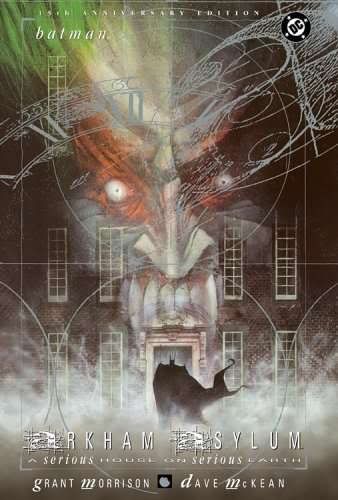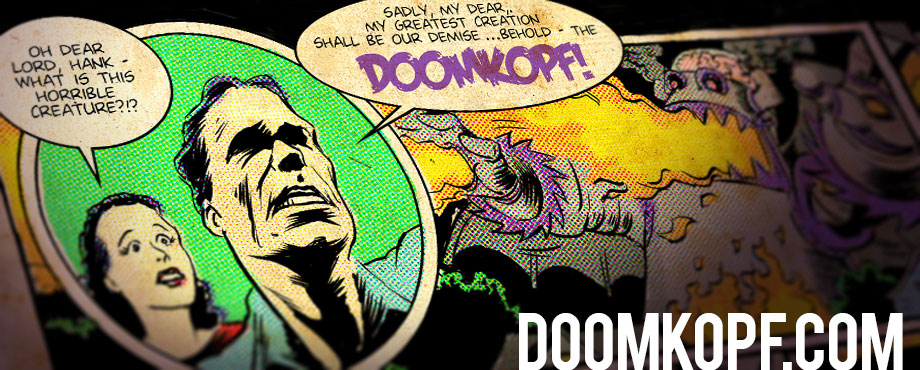Arkham Asylum: A Serious House on Serious Earth
By Grant Morrison and Dave McKean
15th Anniversary Edition published in 2004 by DC Comics
 This won’t be a traditional Library of Doom review because I imagine at this point in human history, 20 years after its initial publication, there are probably few people interested in a traditional review of Arkham Asylum. Prior to last night, I was probably one of the few remaining regular comics readers in 2009 who had yet to read this book, in spite of my good intentions. But last night, I had a 30% off coupon to use, so here we go.
This won’t be a traditional Library of Doom review because I imagine at this point in human history, 20 years after its initial publication, there are probably few people interested in a traditional review of Arkham Asylum. Prior to last night, I was probably one of the few remaining regular comics readers in 2009 who had yet to read this book, in spite of my good intentions. But last night, I had a 30% off coupon to use, so here we go.
Honestly I wasn’t all that excited by the main story. It was interesting to read, worth a little effort to think about, and somewhat pleasing to look at. I seem to have shackled myself quite a bit with this pervasive awareness of my place in the comics review timeline, but I’m just not sure I’m going to have too much to offer in terms of Unique Takes on This Story.
But that’s okay, because I ended up really enjoying the book once I got to the bonus materials. For the Anniversary Edition, DC has included Morrison’s script for the book, including some contemporary notes from the author. Sometimes I skip things like this, but I was underwhelmed enough by the feature presentation that I hoped I’d get a little good out of reading the appendix.
Right away, I started feeling better about my purchase, because Morrison’s script opens up with a full-page description of the introductory panel in the book. He dives into the symbolism, the foreshadowing, the buried meanings, the layers of story — all this stuff he’s tucked into the description of this single image. I thought to myself “All right! I’m going to have to go back and devote some time to re-reading this book and it’s going to be worth it!”
So I flipped back to the first page to see this image of the moon, caught between the two chimeys on the roof of the Arkham House, wet with rain, lit by the semi-circular window below the face of the moon, echoing the imagery of the moon’s card in a Tarot deck … and after some page flipping and more page flipping to confirm that I was in fact at the first page, I realized that Dave McKean simply didn’t do it. Instead, there’s just kind of a half-hearted smudgy moon between two clumsy chimneys and a blob of a reflection — with such crudeness to its construction as to almost exist in contempt of Morrison’s attention to detail.
Before I get too far ahead of myself, there is no doubt that McKean’s art contributed a massive share of what makes this book so legendary. His eerie, dreamlike surrealism is perfect for the subject matter, with dips in and out of lifelike detail like little moments of lucidity. No doubt the editors and creative forces knew what they were doing when they paired that talent with this story.
But you read Morrison’s notes, and you see hints at a battle between what is perhaps a micromanaging writer and an artist who seemed to be none too impressed with what the script called for. There are multiple occasions in just the opening scenes in which Morrison goes into great detail about what he imagines, including some pretty relevant symbolism, but a quick flip back to the book finds these elements completely omitted from the page. It almost seems that the more Morrison asked for, the less he got.
I’m not sure if it’s a hint at some underlying tension throughout the creative process or just a funny little anecdote, but Morrison alludes to McKean’s creative control on the footnote to page 4 when discussing his desire to include Robin in the story: “Dave McKean, however, felt that he had already compromised his artistic integrity sufficiently by drawing Batman and refused point blank to bend over for the Boy Wonder.”
I had a little trouble getting through the main story. The beauty in McKean’s art doesn’t always translate to legible storytelling, and the red font used for The Joker’s lines was extremely hard to read against the dark background. That said, I don’t necessarily fault the book for not wanting to be a straight-forward panel-to-panel superhero story. But reading through the script, and between the lines of his footnotes, you start to see how the Arkham Asylum that emerged is really quite different from the Arkham Asylum that Morrison wrote.
Not that I think it would be worth anyone’s efforts at this point, but it made me wonder how this thing might’ve been received had a more submissive — or at least a more cooperative — artist been assigned the project.

You hit on something that I find interesting about Morrison’s writing. It takes a really good artist/storyteller to bring out what is so great about Morrison’s work. It’s quite a stark contrast when you look at this book or the Tony Daniel drawn Batman work compared to what you get when Frank Quitely draws a Morrison script like on Batman and Robin. For whatever reason Quitely connects perfectly and brings out the the best of Morrison. I never have trouble understanding Morrison’s work with Quitely but with an artist like Daniel I’m often left rather confused by the story at points.
Now that you’ve read that, don’t you think it would be a good idea to check out the Arkham Asylum video game?
Very good point, sir.
Somehow, I haven’t read this yet. I wanted to until a fellow comics writer told me that when he first read it, he made it about 10 pages before getting up, driving to a nearby gas station and throwing the book in the garbage.
I am interested to read more of Morrison’s scripts. Sometimes his work comes across as either too lazy or too high-minded to craft the story in an intelligible way. All-Star Superman was good for the most part, but their are places in the second collection where it seems like crucial panels were cut out. And don’t get me started on Final Crisis…